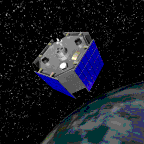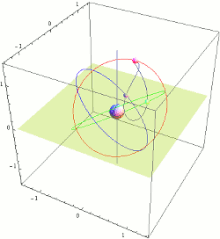Satellite Technology


This learning resource focuses on peaceful use of space technology
Satellite Services
[edit | edit source]Remote Sensing / Earth Observation
[edit | edit source]- Satellite crop monitoring[1]
- List of Earth Observation Satellites[2]
- Low-Cost Precision Farming[3]
- Ground Motion Service: decreasing ground level due to mining, exploitation of water resources, heavy buildings especially in costal regions, which adds risk in conjunction with Climate Change and Global Warming.
Navigation
[edit | edit source]- Satellite navigation[4]
- Global Positioning System[5] (Youtube Video on GPS by sciBRIGHT][6])
- Satellite Navigation with Galileo
Information and Communication Technology
[edit | edit source]Assignment of Satellite Technology to Sustainable Development Goals
[edit | edit source]Measuring goals and targets of Sustainable Development Goals with Space Technology:
- Earth Observation for Sustainable Development
- Sentinel-5P[7] Satellite for Air Quality Monitoring[8] - Carbonmonoxid as indicator for air polution
- Population Distribution Mapping combined with in-situ ground data.
- Earth observation used for coral bleaching in Great Barrier Reef due to Climate change
- Observe deliberate ecosystem destruction (e.g. man-made bush fire and land use).
- Sentinel-3A measures of the Antartic Ice Shield.
- Ocean Altimetry Satellite Data provided ba Sentinel-6 from 2020 for risk management for rise of sealevel due to global warming.
- monitor vulcanic erruption for Risk Management and precautionary measure especially for air travel and consequences for the propulsion engines.
- hurricane monitoring
- Aeolus will provide a 3D wind profile on a global scale
- monitor wetlands and dynamic aspect of seasonal water regimes with Earth Observation and determine the impact of extreme weather events
- tracking animals and monitor the connectivness of habitats (spread of disease vectors).
Major Challenges
[edit | edit source]Big Data
[edit | edit source]- Petabytes of data is downstreamed from operated satellites currently in orbit. The challenge is to process the available data efficiently (see Big Data[9]).
- Our brain processes visual data coming from our retina in our eyes e.g. by more that 1GB/s. Stored are only a few bytes. Explain why this filtering mechanism in our brain is necessary for efficient perception of visual data? What can we learn from neurophysiological data processing and what are the difference processing and storing and processing data from Earth Observation Satellites (e.g. using artificial neural network (ANN) for crop classification and landuse management).
- Satellite data is freely available, but data processing is difficult for satellite data images.
- application of OpenSource technology to process data (e.g. available in Wikiversity as learning resource or checkout scripts that do the processing),
- provision of feedback to obstacles, challenges and sucesses in the discussion tab of Wikiversity to derive future development of Open Educational Resources for application of satellite technology e.g. for Sustainable Development Goals.
- Big Data Machine Learning & Statistics & Numerics Decision Support Products
Real-time Satellite Images
[edit | edit source]Requirements:
- Real-time images in upcoming years 15min data
Data intergration of Earth Observation and Census data
[edit | edit source]Combine detection of buildings by Earth Observation with census data, because in addition to dwellings and buildings the number of people relevant for exposure to hazards.
Reaching People
[edit | edit source]Reaching people are mainly to related to access services that utilize space technology for spatial decision support.
- GPS-sensor on the mobile device allows to tailor information to the geolocation of the user, ...
- Earth Observation is used to provide weather forecast for agricultural activities and provide warnings to local population.
- Satellite communication to allow communication via
Ubiquitous mobile devices with sensors for receiving and processing geolocations. Websites can retrieve geolocation informations with an API even roughly by the IP-address (see Geolocation-API by W3Schools). Maps can be implemented in HTML5 WebApps by OpenSource frameworks like OpenLayers or LeafletJS.
Open Community Approach - Open/Free Satellite Data
[edit | edit source]Sentinell Programme and Landsat Programme provide free access to satellite technology. What are the differences and similarities in the provision of services.
- Copernicus Open Access Hub by European Space Agency (global datasets)
- Earth Explorer for Open Data provided by the US government (global datasets).
- National Oceanographic and Atmospheric Administration (NOAA) by US government (global datasets)
- National Institute for Space Research (INPE) - South Africa (african datasets)
Linux Distribution for Geopspatial Analysis
[edit | edit source]A linux distribution is as OpenSource operating system can provide the basic infrastructure for:
- reduction of installation effort for geospatial tools,
- provide a node to a community for distributed processing of geospatial data,
- establish a link to open data provides
Possible starting point for creating OS-Geo e.g. https://live.osgeo.org, that has already a whole set of geospatial tools preinstalled on the Linx Operating System.
Learning Task
[edit | edit source]- Free Satellite Images and Geographic Information System: Try to calculate the NDVI with the Open Source GIS (e.g. GRASS or QGIS - see Low-Cost Precision Farming)
- Explain, where do you use satellite technology in your daily work and activities!
- Compare GSM Network Communication with Satellite Communication. Explain economic, technical, ... benefits, challenges and limits of the both technological approaches.
- Risk Management can uses a fallback method, in which the failure of one technology allows another technology to replace the service.
- Dust storms are a major hazard, they can be detected from outer space.
- Analyse Jupyter and KnitR and explain the benefits for analyses and decision making!
Advanced Learning Tasks
[edit | edit source]- Satellites revisit time to a specific geolocation implies that users had to wait for a specific time span until they will get a new satellite image of the same geolocation. Analyse applications of earth observation and explain the impact of revisit time on the application of earth observation. Explain the benefits and challenges of linking several satellites to reduce the time span until you get a new image.
- Analyse the following three pillars linked to United Nations and a
- Climate Action (Paris Agreement)
- Disaster Management (Sendai Framework for Disaster Risk Reduction)
- Sustainability (Sustainable Developement Goals)
See also
[edit | edit source]- Disaster Management
- UN-SPIDER
- Expert Focus Group for Space and Global Health (EFG-SGH)
- Calculate a Regional NDVI - Technical tutorial to apply low-cost precision farming.
- Asteroid mining
Links
[edit | edit source]- UNOOSA supporting Sustainable Development Goals in Committee on the Peaceful Uses of Outer Space - COPUOS
- (Earth Observation) GEO Group on Earth Observations, Open Data for the Benefit of Humankind
- (Internet) Wikipedia: Satellite Internet Access
- (Water) Space4Water - Contribution for Space Technology for Water - https://space4water.org.
References
[edit | edit source]- ↑ Groten, S. M. E. (1993). NDVI—crop monitoring and early yield assessment of Burkina Faso. TitleREMOTE SENSING, 14(8), 1495-1515.
- ↑ Frost, A., Singha, S., Jacobsen, S., & Wiehle, S. (2017). High Resolution Sea Ice Motion Estimation from C-and X-Band SAR Data Acquired During Antarctic Circumnavigation Expedition.
- ↑ Foster, A. J., Kakani, V. G., & Mosali, J. (2017). Estimation of bioenergy crop yield and N status by hyperspectral canopy reflectance and partial least square regression. Precision Agriculture, 18(2), 192-209.
- ↑ Prasad, R., & Ruggieri, M. (2005). Applied satellite navigation-using GPS, GALILEO and augmentation systems.
- ↑ Li, X., Zhang, X., Ren, X., Fritsche, M., Wickert, J., & Schuh, H. (2015). Precise positioning with current multi-constellation global navigation satellite systems: GPS, GLONASS, Galileo and BeiDou. Scientific reports, 5.
- ↑ How does GPS work? by sciBRIGHT - Youtube published 2016/09/16 (accessed 2017/09/11) - https://www.youtube.com/watch?v=FU_pY2sTwTA
- ↑ Berger, M., Moreno, J., Johannessen, J. A., Levelt, P. F., & Hanssen, R. F. (2012). ESA's sentinel missions in support of Earth system science. Remote Sensing of Environment, 120, 84-90.
- ↑ Zoogman, P., Liu, X., Suleiman, R. M., Pennington, W. F., Flittner, D. E., Al-Saadi, J. A., ... & Janz, S. J. (2017). Tropospheric emissions: Monitoring of pollution (TEMPO). Journal of Quantitative Spectroscopy and Radiative Transfer, 186, 17-39.
- ↑ Guo, H., Wang, L., Chen, F., & Liang, D. (2014). Scientific big data and digital earth. Chinese science bulletin, 59(35), 5066-5073.

